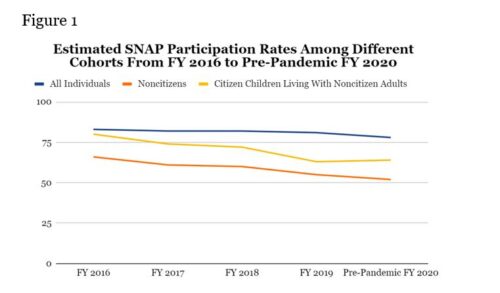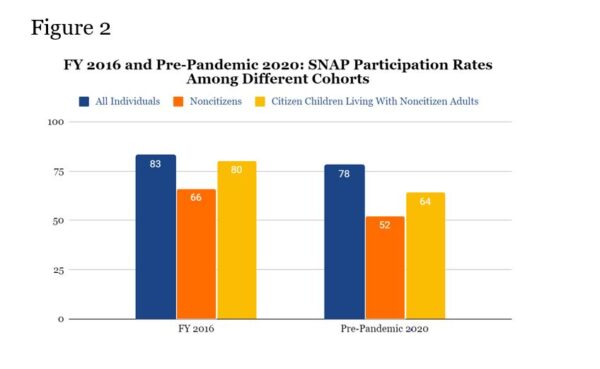January 26, 2023
This blog is Part 1 of a two-part series focused on SNAP and eligible immigrant families. Part 1 reviews key SNAP participation data trends and lifts up the importance of the new Biden administration public charge rule as a critical step in helping to reverse SNAP participation decreases among eligible immigrant households. Part 2 will examine opportunities to address barriers that impede immigrant access to SNAP in addition to leveraging the new rule.
On December 23, 2022, the U.S. Department of Homeland Security’s final public charge rule went into effect — ringing in good news for supporting immigrant access to vital programs that keep families healthy, housed, and nourished. The final rule unequivocally states that, applying for or receiving the Supplemental Nutrition Assistance Program (SNAP) – as well as Medicaid and housing benefits — will have no impact on immigrants seeking to adjust their immigration status.
| What Is Public Charge?
When certain noncitizens apply for lawful permanent resident status (to get a green card) or to enter the U.S., they must pass a public charge test. This means that immigration officials look at a range of factors about the applicant’s life and make a determination about whether the applicant is likely to rely on the government as their main source of support in the future. As one of many factors, immigration officials look at whether the applicant has received government cash assistance–such as Supplemental Security Income, Temporary Assistance for Needy Families, or state and local cash assistance programs–or long-term institutionalization paid for by the government. SNAP and other nutrition programs are not included in public charge tests. For background on public charge and the many categories of immigrants public charge does not apply to, see the Protecting Immigrant Families Coalition. |
SNAP and Immigration Status
SNAP is available to certain lawfully present noncitizens, including refugees, asylees, and children who are lawful permanent residents. With few exceptions, lawful permanent resident adults still must wait five years before being eligible for SNAP. In addition to meeting status requirements, immigrants must also meet program eligibility criteria such as income and asset tests. Applying for or receiving SNAP will not affect a noncitizen’s ability to:
See this joint letter from the U.S. Department of Agriculture (USDA), the U.S. Citizenship and Immigration Services, and the U.S. Citizenship and Immigration Services, as well as USDA’s Non-Citizens & FNS Programs webpage for messaging you can use in your community. |
While this rule is an essential step in easing immigration-related fears about accessing government programs, damage done during the Trump administration continues to cause challenges. Several new research pieces further underscore the negative impact of the Trump administration’s harmful policy and rhetoric aimed at immigrant families, as well as struggles faced by immigrant families during the COVID-19 pandemic. The impact as it relates to SNAP access is evident in participation gaps.
SNAP Participation Trends
SNAP participation among eligible immigrants and mixed-status households has lagged behind that of U.S. citizens for decades. However, these decreases in participation were exacerbated from fiscal year (FY) 2016 to pre-pandemic fiscal year 2020.*
This period coincided with an upswing in harmful anti-immigrant rhetoric as well as the adoption of damaging policies, such as the 2019 public charge rule, which (for the brief period it was in effect) for the first time ever counted SNAP as a negative factor in a public charge determination.
As shown in Figure 1, SNAP participation rates for eligible noncitizens and for U.S. citizen children living with noncitizen adults both declined substantially from FY 2016 to pre-pandemic FY 2020; whereas, SNAP participation rates for all individuals remained relatively flat.

Figure 2 captures how the anti-immigrant political backdrop — from FY 2016 to pre-pandemic fiscal year 2020 — helped fuel SNAP participation decreases among eligible immigrants and mixed-status families and widened participation gaps.

In FY 2016, SNAP participation rates among citizen children living with noncitizen adults was 80 percent, only 3 percentage points lower than SNAP participation rates among all individuals at 83 percent. By pre-pandemic 2020, this gap had widened by 14 percentage points.
The gap in SNAP participation between all individuals and noncitizens was at 17 percentage points in FY 2016 and widened to 26 percentage points in pre-pandemic 2020.
Lost in these numbers are the deep harms families experienced — especially during the fallout of the COVID-19 pandemic economic and public health crisis — as some immigrant families were not eligible for, or were scared away from accessing the vital nutrition assistance of SNAP.
While the new public charge rule is an essential step in helping eligible immigrant families access SNAP and mitigate hunger, there is still much work to be done to ensure all families, regardless of immigration status, can access the nutrition they need to thrive.
Stay tuned for Part 2 in this blog series where we’ll examine opportunities to address barriers that impede immigrant access to SNAP.
*Pre-pandemic fiscal year 2020 refers to October 2019 through February 2020. Because of the impact of the COVID-19 public health emergency on data collection, USDA statistics are reported by pre-pandemic period of October 2019 through February 2020 and the early pandemic period of June to September 2020 (March through May were not reported). Data related to SNAP participation among eligible immigrants at the national level are not available for the early pandemic period.

